Why the Arizona Daily Star went *all in* on women's basketball coverage
"It sells papers."
Hi, friends! So, back in May, Power Plays published a #CoveringtheCoverage feature looking at how newspapers covered the 2021 women’s NCAA basketball tournament.
If you need a quick recap — which, I’d be worried if you didn’t — the great Tori Burstein and I looked at print editions of six newspapers from across the country: USA Today, Los Angeles Times, Dallas Morning News, Chicago Tribune, Washington Post, and New York Times. We tallied the articles in these papers from Wednesday, March 31 (the day after the men’s and women’s Elite Eights concluded) through Monday, April 5 (the day after the women’s championship game, and the day of the men’s championship game.)
Our biggest takeaway? The men’s tournament received almost twice as much coverage (21.41%) as the women’s tournament (11.41%). Not great!
Additionally, we also took a quick look at the coverage women’s Final Four teams received from local papers — The State (South Carolina), Hartford Courant (UConn), San Francisco Chronicle (Stanford), and Arizona Republic (Arizona).

We didn’t draw too many sweeping conclusions from this data, but overall, as this chart below shows, I was left wanting more.
Well, it turns out there was more. I just hadn’t looked for it in the right place.
Right after publishing that newsletter, a lot of my Tucson followers kindly let me know that I had screwed up; Arizona Republic was not the local paper for the University of Arizona, because the Arizona Republic is in Phoenix, duh. The Arizona Daily Star was the local paper in Tucson, and according to my readers, the Daily Star’s coverage of the Wildcats and their NCAA tournament run was exceptional.
My readers, as usual, were right. Just look at these front pages!
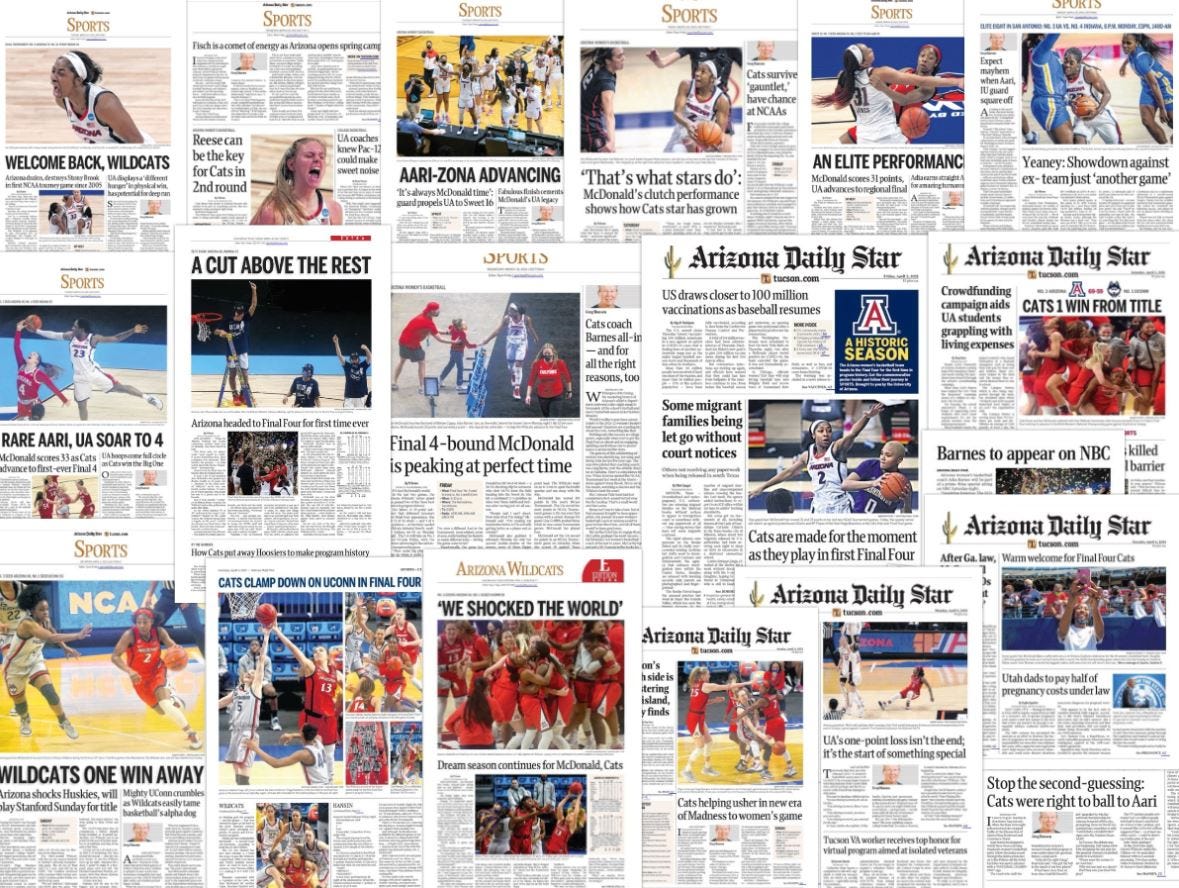
Because of this, I decided to talk to the folks at the Arizona Daily Star, and take a deep dive into hyper-local coverage and the important role it plays in driving women’s sports forward.
I know that we are *quite* a few weeks (read: months) past the women’s NCAA tournament, and that is completely my fault, but I think the lessons from this piece are timeless.
So, come on, friends, and take a trip with me over to Tucson.
Covering the Madness
The Arizona Daily Star has always covered the Arizona women’s basketball team. It covers all the teams at the University of Arizona. But the sport hasn’t always the paper’s shining jewel.
“Until about 2019, they weren’t only bad, they were terrible,” Ryan Finley, the sports editor at The Daily Star, told Power Plays. “We covered games, obviously. We wrote what we could about good individual performances. But they didn't draw, and it was really rough time for women's basketball.”
Finley remembers exactly when that started to change — it was the summer of 2016, when Wildcat legend Adia Barnes was hired as the new head coach of the women’s basketball program, and sportswriter PJ Brown started freelancing for the Daily Star’s sports section.
Barnes was by far the most successful player in Arizona women’s basketball history. She broke nearly every record in the book during her playing days in Tucson, then played for seven years in the WNBA and six more seasons internationally, before taking a job as an assistant coach at the University of Washington in 2011. Five years later, she took over an Arizona program that hadn’t made it to the NCAA tournament since 2005. When she was hired, the community was immediately intrigued.
“She was such a big name from the second she took over that readers were interested,” Finley said. “Readers wanted to know how Adia Barnes was building this team and who her coaches were and what the schedule look like.”
Barnes didn’t turn things around overnight; there was a very slight adjustment period. In the 2016-17 season, she led the team to a 14-16 record. That offseason, Barnes convinced star Washington guard Aari McDonald to transfer to Arizona. In 2017-18, with McDonald taking a redshirt season, Arizona went a paltry 6-24.
But the 2018-19 season was a turning point for the program; Aari McDonald finally saw the court, and the Wildcats went 17-12 in the regular season and were rewarded with a spot in the WNIT tournament, which they won by taking down Northwestern in the championship game in front of a sold-out crowd of 14,644 at the McKale Center. That momentum carried over to the 2019-20 season, when they went undefeated in non-conference play and scored top-10 wins over UCLA, Oregon State, and Stanford. They finished the season ranked No. 13 in the nation, and would have returned to the NCAA tournament for the first time in 15 years if it wasn’t for the coronavirus canceling the postseason.
By then, the team was getting about five stories a week in the Daily Star, and was a regular fixture on the front page of the sports section.
“[Barnes is] so accessible, and she's really skilled with the media, knowing what we want, being there to answer whatever questions we might have,” Finley said. “And so part of it was just Adia's personality, and part of it was PJ knowing the sport, and having such a good working relationship with her that she had access to information to write [multiple] stories a week.”
Brown moved to Tucson in late 2015 after a long career covering sports at papers all over the country, including the Chicago Tribune, Chicago Sun Times, Daily Herald, and Danville Register, before starting her own marketing and communications business. Brown had always loved women’s basketball — she grew up following Tamika Catchings’ high-school career in Chicago, and became a Lady Vols fan when Catchings went to Tennessee to play under Pat Summitt — but had never exclusively covered the sport, and didn’t have any plans to. By the time she moved to Tucson, she thought she was done with sports reporting, period.
But she wanted to get involved in the Tucson community, so when a friend introduced her to Finley, she ended up sending him her clips.
“We made a deal that I would try it out. And if I didn't like [freelancing for the Daily Star], if it wasn't fun, then I would just stop right? And it would be okay. No hard feelings,” Brown said.
Well, spoiler alert: She liked it. It was fun. Especially once she started writing about Barnes and the women’s basketball team. In early 2017, she officially earned the beat.
“To me, this is like the dream I had when I was a little kid,” Brown said. “I wanted to cover big-time college sports. I have this great editor. It's fun. And it's a collaboration. It's a true collaboration.”
This past season, Brown had a front-row seat — well, virtually, at least — to Arizona nabbing a 13-4 conference record to finish in second place in the Pac-12. Then, in March, she got to cover the team’s improbable and historic run to the NCAA championship game, which included wins over Texas and Indiana in the Sweet 16 and Elite Eight respectively, and a huge upset over UConn in the Final Four before a one-point loss to Stanford in the final.
Brown spoke with me at length this spring about how she approaches covering women’s basketball, what makes Adia Barnes so special, the extensive coverage the paper gave the team during the NCAA tournament, how Arizona’s WNIT run changed everything, the welcome reception Tucson gave the team after they lost the NCAA championship game, and why more newspapers should invest in women’s sports coverage. I really think you all will love this one.
The following interview has been edited and condensed for clarity. I have italicized a few parts for emphasis.
Power Plays: When you started covering Arizona women’s basketball, what was your game plan? How did you go about establishing relationships with the team?
PJ Brown: Adia’s first year, we knew it was going to be a weird transition period, right? When she first came, she had, like, no recruiting class. They won 14 games that year, and then the next year they only won six. But that six-win season, I wrote four stories a week on them. So I had to approach the stories differently.
My approach was, why not show the fans behind the scenes and write stuff that they never would see otherwise? In one case, I followed a senior around to write a day-in-the-life article. We went to class, we went to breakfast, she got treatment before practice, and then I sat through practice. Then I did a thing with the performance coach, where I did a workout designed for one of the players. We had a photographer there to take pictures, and it was like: An average person, can they survive the workout? Which I did!
Then when I write features, I write more about the person than the statistics. They are full people besides who they are as basketball players.
After that six-win season, I got a couple of really big exclusives from Adia. The one that came at the end of the [2017-18] season, I guess that was the real big one. She reconnected with her father, Pete Barnes, who was an NFL player. Her parents divorced when she was three and her mom ended up remarried a little later, and her biological father really wasn't in her life. Then she played all over the world and she was gone all the time, so they were kind-of estranged.
But [a few years ago] she got a call from one of his friends saying that he was really bad shape. He had dementia, and he was getting worse, and he was living in a place where they were taking advantage of him, like telling him twice a month, “Oh, you didn't pay your rent yet.” And he would pay. So she went down there, and she ended up moving him to Tucson, to a home where he could be taken care of, and they reconnected and they formed a bond towards the end of his life.
She felt comfortable enough to give that story to me, and so I wrote that story. Then she came to me with more stories.
Adia also has a Monday radio show. And [in non-pandemic times] I would go to the radio show and get stuff from the radio show, and she would bring a player and I would sit down with the player and get a one-on-one. I told [the editor], ahead of the third year, that we needed more than four stories a week. There was too much time in-between stories. And he said, “Okay, whatever you want to do.” So we added Wednesday's notes. Then this year, because they’ve gotten so good, we started adding a feature that we have for our coverage of the men’s team, “By the numbers.”
PP: Like the rest of the world, I absolutely fell in love with Adia during the NCAA tournament. So I have to ask, what is it like covering her?
PB: Within the first few minutes of talking to her you're like, like, “Who is this woman?” She's so charismatic and so dynamic, and you're just sucked into her world. Right away, you’re on board. You feel like you want to run through the wall for this woman. Like, you could see playing for her and giving it your all because she's just a force of nature. I've never met anybody like Adia. I think most people have that first impression.
I mean, I see now, what's happened with the tournament, with people jumping on board and becoming Arizona fans and Adia fans. And they all were like, “Oh my god. I love her.” And that's what happens. She's so real and so genuine. She's your neighbor, she's your sister, she's really down to earth. She talks about everyday things, like having issues with the whole thing of being a mom and having to breastfeed her baby; even if you're not a mom and you haven't gone through that, you feel like you've done it, like you're right there with her.
PP: Is there something about Tucson and/or the University of Arizona that makes it uniquely primed to devour women’s basketball coverage?
PB: I think it’s a combination of things. I think we’re really unique, first of all. There are people I call Super Fans who followed [Barnes] when she was here as a player, and they crave the stories. And my editor, like I said, he’s a rockstar. He’s very open to it all. There was a time, I think it was after they won the WNIT, where he said, “Anything that Adia Barnes does is news.”
And the other thing is, the WNIT run changed everything. They had a nice season [in 2019], but nobody expected this. Players all of a sudden flipped a switch, and you could tell before the first game, they were just in a different space, they were in it to win it all.
So in the first game [of the WNIT in Tucson], the normal amount of their fans came out, maybe 2-3,000. Then Adia gets on Twitter, and she starts trying to get the fan base riled up and get them out: “I want to see a certain number of fans. If you buy tickets, this is going to happen.” Then other coaches got involved. So the football coach bought tickets, alumni bought tickets, all to give to the community.
The other thing I didn't mention is Adia Barnes is really in the community. That was like the first thing she did when she got here. So they do good [work in the community], and people feel like an extended member of the family. After games — when people can go in person to these games — the team does their huddle, and then they go around the rim of the arena and they high five and they hug fans. I mean, that doesn't happen places. It's standing-room only for the radio station in the line to see the players and Adia. They all feel like they're part of this team. Part of it is what Adia Barnes has built here, getting out in the community. And part is I think what we as a paper have done.
We covered her doing the Twitter stuff [during the WNIT]. And the next game more people came, then she tweeted more and then it got bigger, and kept getting bigger, and then they had a sell out for the championship game! It was like unheard of. But it was this grassroots sort thing. And it was a combination of here's somebody doing good things in the community, and people like her and they like her players, right? And then they read about them, and then they get more excited, and they feel part of it. And then there's this momentum that grows.
And for the paper? It sells papers. These stories have the most clicks of other stories in the paper.
PP: What was your coverage plan going into March Madness?
PB: The farthest the program ever went was the Sweet 16 in Adia's senior year. So we decided if they won that game, then we’d go [to San Antonio] the next day so we could be there for the Elite Eight game, because that's history. And we had to be there for history.
That was the plan. I was just writing every day. In San Antonio, I was just in my hotel room writing stories, two stories a day, or whatever it was. It was really intense and narrowly focused.
We also had a photographer in San Antonio, and then Greg Hansen, the columnist, came out for the Final Four. We got really good space in the paper. The whole NCAA run, from about a week before, everything was on the front page. There were some days we had three stories on the front page if I had notes, and a feature or something, and then the columnist wrote columns. We even published four special sections during the run! And when I came back, there was two more weeks of writing every day because there was more news. It just didn't end. It really isn't ending.
This conversation goes back and forth when people argue that nobody wants to read about women’s sports or there isn't an appetite. Well, there is. There are good stories everywhere.
While we have a unique story here, at every single school, the coach is interesting, the players are interesting. They all have great stories. We all should be writing about them. The more you write, the more people read, the more they will pay attention. It grows the fanbase. I think it’s on the publications to realize that women’s sport is big, and they should be covering it.
PP: I have to admit — I’m still stuck on the fact that there were *multiple* special sections!
PB: It was incredible. I was just looking at those sections again. One was a wraparound to the sports section, and other ones were like 12 or 14 pages long. The more ads we got, the more stories we ran. It's just a lot of clicks, a lot of reads, and a lot more revenue coming in from their run.
And, you know, the other thing is Tucson's a basketball town. The last time any basketball team went to the NCAA tournament and went to the championship game was when Lute Olson won it all in 1997.
When the women’s team came back [the day after losing the NCAA championship game], there was a big celebration in the football stadium. The mayor made sure they had it. When the plane landed the fire trucks were there pouring water on them as they came out.
[Every] player who I talked to, and Adia, all said they still felt bad about the loss; that was still sitting with them 12 hours later. But as they drove to campus, there were people lined up in the streets with signs. And as all this is happening, their hearts got full, and it was like they had won. I mean, what a special moment for them.
Thanks so much for reading Power Plays, friends! Talk soon!


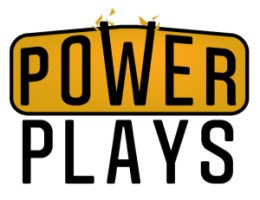

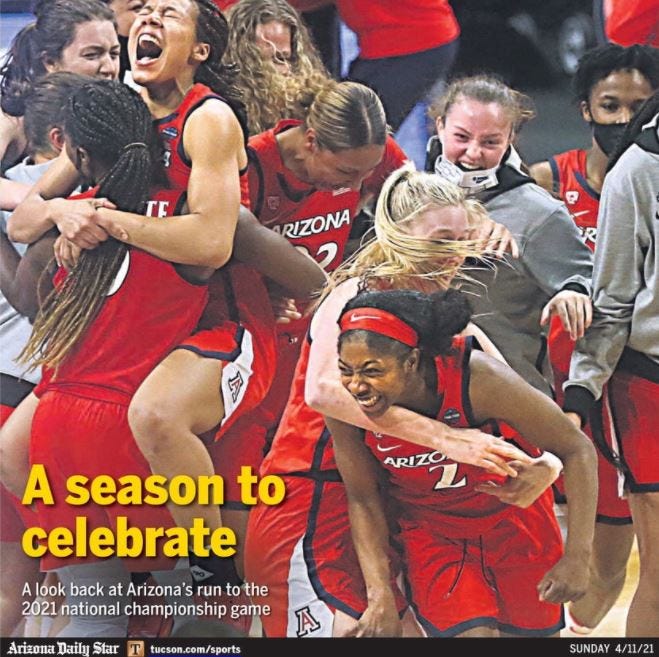

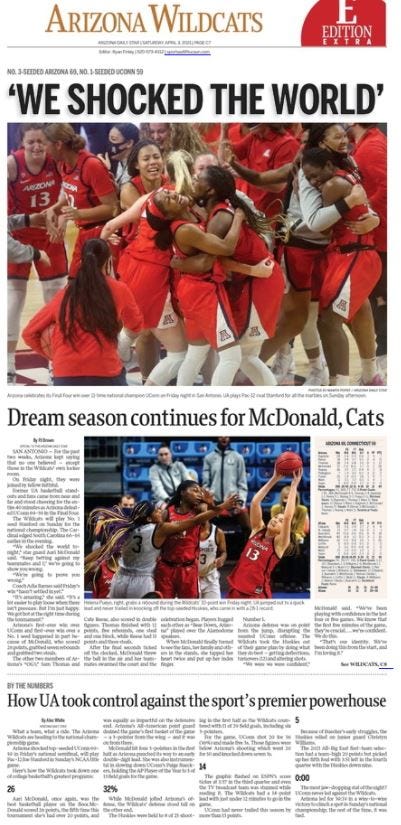
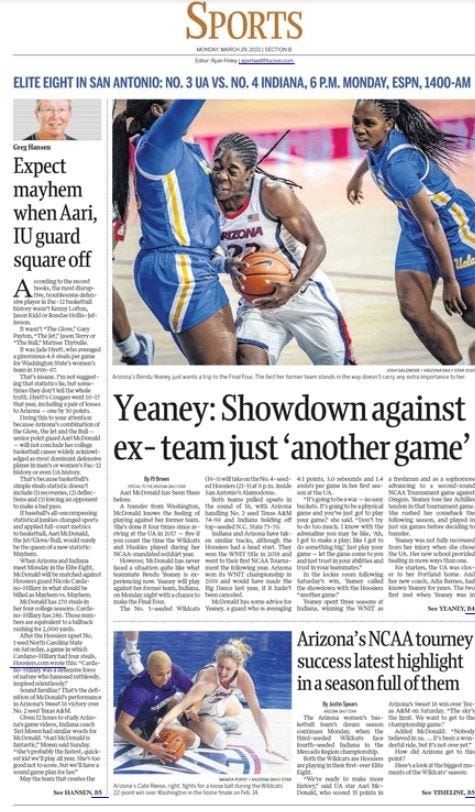
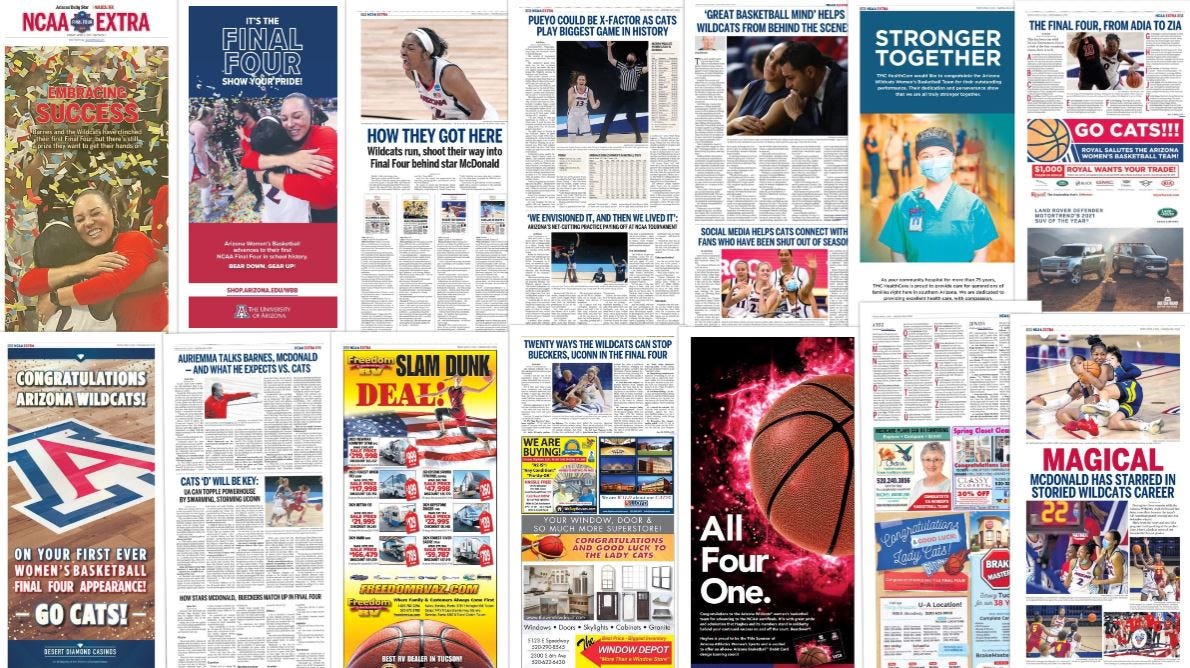
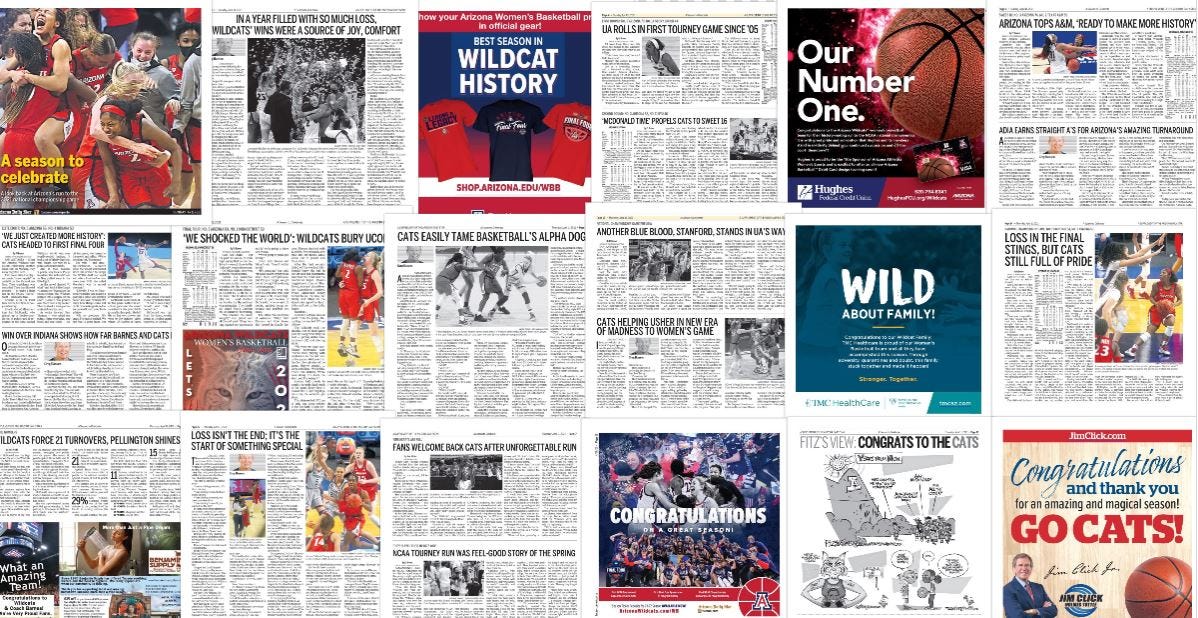
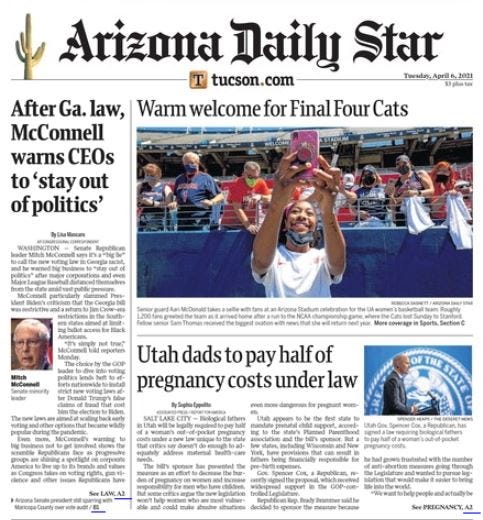
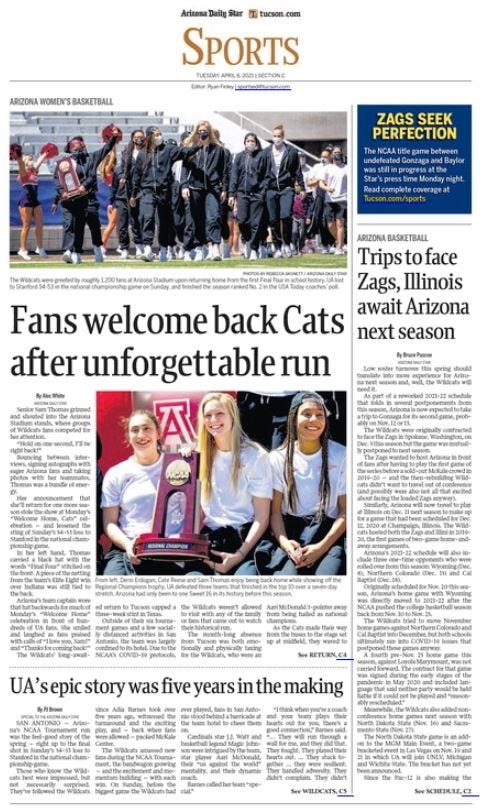
This was so good. Would love to see a look at how different coaches build up the support for and coverage of their WBB teams. The returning player angle was really successful for Adia at Arizona